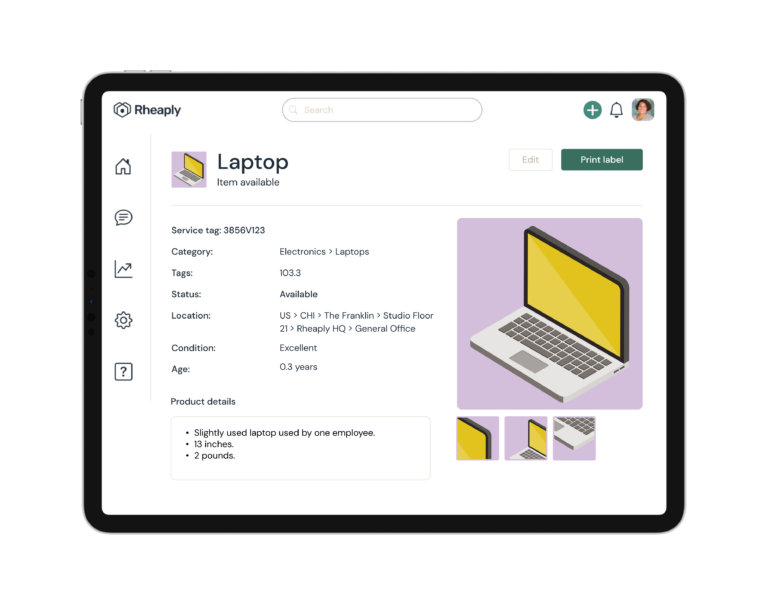Enterprise Inventory Management Software
Rheaply puts reuse on the table for every organization.
Enterprise Inventory Management Software
Enterprise inventory management software is a comprehensive solution for managing and optimizing inventory for modern businesses. It is designed to help enterprises streamline their inventory management processes, reduce costs, and improve operational efficiency.
This software integrates with various systems, such as warehouse management, point of sale, and purchasing, to provide a unified view of inventory across the entire enterprise. It allows companies to track inventory levels and manage real-time supply chain activities. Additionally, enterprise inventory management software provides advanced analytics and reporting capabilities, allowing businesses to make data-driven decisions and optimize inventory levels.
Inventory optimization software for enterprises is also critical to enterprise asset management systems. Businesses can reduce excess inventory, minimize stockouts, and increase profitability by optimizing inventory levels. It helps enterprises improve customer service by ensuring product availability and timely order fulfillment.
Moreover, enterprise inventory management software is crucial in supply chain management by providing insights into product demand and supplier performance. It helps enterprises to collaborate with suppliers and optimize their procurement processes, thereby reducing costs and improving operational efficiency.
Inventory management software examples:
- QuickBooks is a popular accounting software that includes inventory management features. It enables businesses to track inventory levels, create purchase orders, and manage vendor information. It also provides real-time insights into inventory levels and helps companies optimize them.
- Fishbowl is another comprehensive inventory management software with advanced tracking and management features. With Fishbowl, users can manage multiple warehouses, track inventory levels in real time, and generate customized reports. The platform also integrates with popular e-commerce solutions like Shopify and Amazon.
- Zoho Inventory is a cloud-based software with real-time inventory tracking, order management, and supplier management features. Users can automate inventory management processes, improve order fulfillment times, and reduce inventory costs. Zoho Inventory offers advanced reporting and analytics capabilities, making it possible for companies to drive more efficient decision-making.
Inventory Management System
Inventory management systems are software solutions that enable businesses to track, manage, and optimize their inventory levels. These systems provide real-time visibility into inventory levels, automate inventory management processes, and provide advanced analytics and reporting capabilities. Several types of inventory management systems exist, including perpetual inventory systems, periodic inventory systems, and Just-in-Time (JIT) inventory systems.
Perpetual inventory systems are the most common inventory management systems businesses use today. They provide real-time visibility into inventory levels, enabling companies to track them continuously. This inventory management system uses technology, such as barcodes and RFID, to track inventory levels and automate inventory management processes.
Periodic inventory systems, on the other hand, require manual inventory counts to determine inventory levels. This type of inventory management system is less common today but is still used by some businesses. Periodic inventory systems are often used by small companies with low inventory levels or businesses that do not have access to the technology required for perpetual inventory systems.
JIT inventory systems are another type of inventory management system that is designed to minimize inventory levels and reduce costs. JIT inventory systems enable businesses to order inventory only when it is needed, reducing the need for excess inventory. This type of inventory management system requires close collaboration with suppliers to ensure the timely delivery of inventory.
Inventory control software solutions are a critical component of inventory management systems. These software solutions provide advanced inventory tracking and management features, enabling businesses to track inventory levels in real time, automate inventory management processes, and optimize inventory levels.
Inventory control software solutions also provide advanced reporting and analytics capabilities, allowing businesses to make data-driven decisions about their inventory management activities.
Inventory Tracking Software For Enterprise
An inventory management system project is a strategic initiative a business undertakes to implement an inventory management system that enables efficient and effective inventory tracking and management. The project’s primary goal is to optimize inventory levels, boost efficiency, and ultimately improve a company’s bottom line by increasing sales.
The steps involved in an inventory management system project typically include the following:
- Define project objectives: The first step is to clearly define the project’s goals, including what you hope to achieve by implementing the new inventory management system. Consider where you currently stand and where you hope to be within your desired timeframe. This can help set the pace for the ensuing steps.
- Analyze inventory processes: Next, analyze existing inventory processes to identify inefficiencies and areas for improvement. This might involve reviewing current inventory tracking methods, identifying data collection gaps, and assessing the accuracy of inventory records.
- Determine software requirements: Based on the results of the inventory process analysis, determine your software requirements and identify the features and functionalities needed for inventory management. This is key to finding the software that works best for your business.
- Select a software vendor: Once the software requirements have been identified, select a software vendor that meets your needs. Be sure to thoroughly evaluate different enterprise inventory tracking software based on cost, ease of use, and scalability.
- Implement the new system: Implement the new inventory management system. This process typically includes configuring the software to meet your organization’s specific needs, importing existing inventory data, and training employees on using the new system.
- Monitor and optimize: The final step is an ongoing process. Once the new inventory management system has been implemented, you should continuously monitor its performance and maximize inventory processes to ensure that all objectives are achieved.
While getting started with an inventory tracking system presents challenges, having a specialized software platform for managing inventory is invaluable. Platforms like Rheaply are similarly helpful for determining how to manage excess inventory.
With Rheaply’s inventory management solution, businesses can find, track, and manage their resources more efficiently. In addition, because Rheaply supports a circular economy, organizations can do their part to reduce carbon emissions and promote a more sustainable supply chain.



